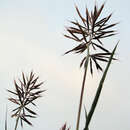Comprehensive Description
provided by North American Flora
Erianthus tracyi Nash, Bull. Torrey Club 24 : 37. 1897
r
S/^ms 2-4 m. tall, the summit and nodes, together with the panicle-axis and top of the otherwise glabrous sheaths, appressed-pubescent with long silky hairs ; leafsheaths shorter than the internodes ; blades 5 dm. long or more, 1.5-3 cm. broad, very rough, pilose above at the base; panicle 3-5 dm. long, 8-12 cm. wide, oblong, its pubescent branches erectascending, the larger 1-1.5 dm. long; spikelets crowded, less than one half as long as the basal hairs and one half again as long as the internodes ; outer 2 scales 5-6 mm. long, pilose with hairs twice as long as the scale ; fourth scale entire or somewhat 2-toothed at the apex, the awn 1.5-2 cm. long, straight or slightly flexuous.
Type locality : Starkville, Mississippi. Distribution : Mississippi and Louisiana.
- bibliographic citation
- Percy Wilson, Per Axel Rydberg, Norman Taylor, Nathaniel Lord Britton, John Kunkel Small, George Valentine Nash. 1909. PANDANALES-POALES; TYPHACEAE, SPARGANACEAE, ELODEACEAE, HYDROCHARITACEAE, ZANNICHELLIACEAE, ZOSTERACEAE, CYMODOCEACEAE, NAIADACEAE, LILAEACEAE, SCHEUCHZERIACEAE, ALISMACEAE, BUTOMACEAE, POACEAE (pars). North American flora. vol 17(1). New York Botanical Garden, New York, NY
Comprehensive Description
provided by North American Flora
Erianthus laxus Nash, Bull. Torrey Club 24 : 344. 1897
Stems 2-3 m. tall, pubescent, especially at the nodes, with appressed hairs, those at the apex and on the panicle-axis long and copious ; leaf -sheaths, particularly the lower ones, densely hirsute, especially at the ends ; blades 2-5 dm. long, 6-12 mm. wide, hirsute on both surfaces, the upper surface becoming glabrous ; panicle 4-5 dm. long, 1 dm. wide or less, its elongate and ascending branches lax and flexuous, the larger 2-2.5 dm. long; spikelets loosely disposed, about one half as long as the basal hairs and much exceeded by the internodes, especially by the lower ones ; outer 2 scales 4-5 -mm. long, pilose with long hairs ; fourth scale entire or shortly 2-toothed at the apex, the awn straight or slightly flexuous, about 2 cm. long.
Type locality : Between Paola and the Wekiva River, Florida. Distribution : Known only from the type locality.
- bibliographic citation
- Percy Wilson, Per Axel Rydberg, Norman Taylor, Nathaniel Lord Britton, John Kunkel Small, George Valentine Nash. 1909. PANDANALES-POALES; TYPHACEAE, SPARGANACEAE, ELODEACEAE, HYDROCHARITACEAE, ZANNICHELLIACEAE, ZOSTERACEAE, CYMODOCEACEAE, NAIADACEAE, LILAEACEAE, SCHEUCHZERIACEAE, ALISMACEAE, BUTOMACEAE, POACEAE (pars). North American flora. vol 17(1). New York Botanical Garden, New York, NY
Physical Description
provided by USDA PLANTS text
Perennials, Terrestrial, not aquatic, Rhizomes present, Rhizome short and compact, stems close, Stems nodes swollen or brittle, Stems erect or ascending, Stems caespitose, tufted, or clustered, Stems terete, round in cross section, or polygonal, Stem nodes bearded or hairy, Stem internodes solid or spongy, Stems with inflorescence 1-2 m tall, Stems with inflorescence 2-6 m tall, Stems, culms, or scapes exceeding basal leaves, Leaves mostly cauline, Leaves conspicuously 2-ranked, distichous, Leaves sheathing at base, Leaf sheath mostly open, or loose, Leaf sheath smooth, glabrous, Leaf sheath hairy at summit, throat, or collar, Leaf sheath and blade differentiated, Leaf blades linear, Leaf blades 1-2 cm wide, Leaf blades mostly flat, Leaf blades more or less hairy, Leaf blades scabrous, roughened, or wrinkled, Ligule present, Ligule a fringed, ciliate, or lobed membrane, Inflorescence terminal, Inflorescence an open panicle, openly paniculate, branches spreading, Inflorescence solitary, with 1 spike, fascicle, glomerule, head, or cluster per stem or culm, Inflorescence branches more than 10 to numerous, Flowers bisexual, Spikelets pedicellate, Spikelets sessile or subsessile, Spikelets dorsally compressed or terete, Spikelet less than 3 mm wide, Spikelets with 1 fertile floret, Spikelets with 2 florets, Spikelets paired at rachis nodes, Spikelets all alike and fertille, Spikelets in paired units, 1 sessile, 1 pedicellate, Spikelets bisexual, Inflorescence disarticulating between nodes or joints of rachis, rachis fragmenting, Spikelets disarticulating below the glumes, Spikelets falling with parts of disarticulating rachis or pedicel, Inflorescence branches deciduous, falling intact, Spikelets conspicuously hairy , Rachilla or pedicel glabrous, Glumes present, empty bracts, Glumes 2 clearly present, Glumes equal or subequal, Glumes equal to or longer than adjacent lemma, Glume surface hairy, villous or pilose, Glumes 1 nerved, Lemmas thin, chartaceous, hyaline, cartilaginous, or membranous, Lemma 1 nerved, Lemma apex acute or acuminate, Lemma distinctly awned, more than 2-3 mm, Lemma with 1 awn, Lemma awn 1-2 cm long, Lemma awned from tip, Lemma awns straight or curved to base, Lemma margins thin, lying flat, Lemma straight, Callus or base of lemma evidently hairy, Callus hairs shorter than lemma, Callus hairs equal to lemma, Stamens 2, Styles 2-fid, deeply 2-branched, Stigmas 2, Fruit - caryopsis.

